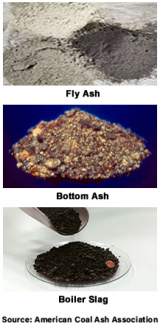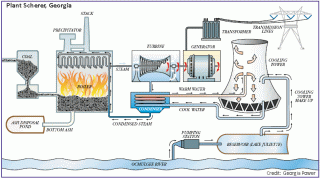Radioactive Wastes From Coal-fired Power Plants
- The process of burning coal at coal-fired power plants, called combustion, creates wastes that contain small amounts of naturally-occurring radioactive material.
Coal is a fossil fuel used to produce power in the United States. Coal contains trace amounts of naturally-occurring radioactive elements. The process of burning coal at coal-fired power plants, called combustion, produces wastes that contain small amounts of naturally-occurring radioactive material (NORM).
About Radioactive Wastes From Coal-fired Power Plants

Source: American Coal Ash Association
Like all rocks, coal contains small amounts of radioactive elements that are found naturally in the environment. When coal is burned to create heat and steam to produce power it is called combustion. During coal combustion, natural radioactive material in coal concentrates in three main waste streams:
- Fly ash is a light colored, fine particle waste that resembles a powder. The majority of coal combustion wastes are fly ash.
- Bottom ash is a larger particle size than fly ash and is a heavier waste that resembles a mix of sand and small rocks. Just over 10% of coal combustion waste is bottom ash.
- Boiler slag is made when bottom ash melts under the intense heat of combustion. Boiler slag resembles the size of gravel. It makes up about 2% of coal combustion waste.
Generally, these wastes are only slightly more radioactive than the average soil in the United States. The amount of natural radiation in wastes from coal-fired power plants is so small that no precautions need to be taken.
While 99% of fly ash is captured by filters, small amounts (about 1%) can escape into the air. Government regulations require power plants to limit the amount of fly ash that escapes into the environment and to dispose of collected ash properly.
Source: United States Geological Survey (USGS)
A survey by the American Coal Ash Association showed that more than 50% of all fly ash, bottom ash and boiler slag is reused in other products. Some ways that these wastes can be reused include: concrete, blended cement, to fill structures or embankments, as blasting grit or as roofing granules.
What You Can Do
- Know the regulations. While the amount of radiation in wastes from coal-fired power plants is very small, there are other harmful emissions from power plants and industrial sources that are regulated. You can learn more about the EPA’s air pollution standards by visiting the Plain English Guide to the Clean Air Act.
You can view air quality information for your area from any type of emission at the EPA’s AirNow website.

